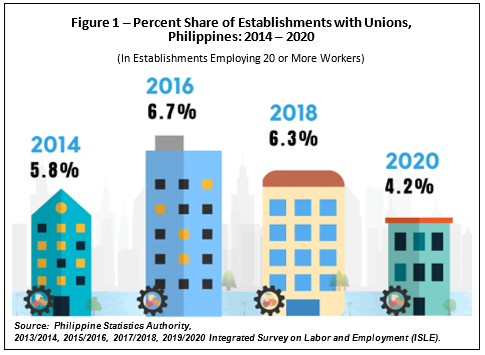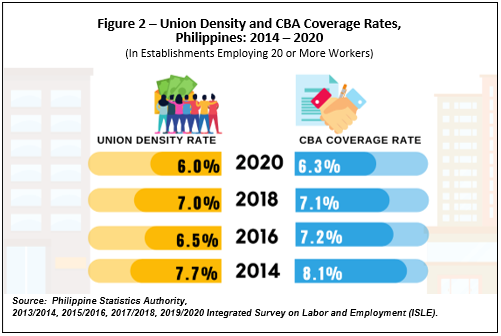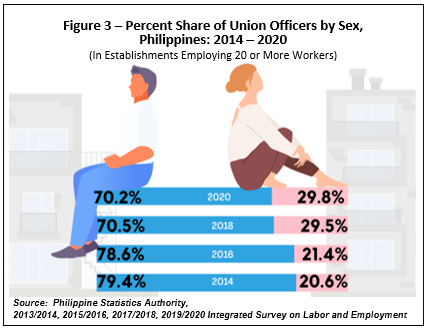Release Date :
Reference Number :
2019-211
EXTENT OF UNIONISM
- Survey results showed that 6.3 percent (2,039) of establishments with 20 or more workers (32,517) had unions in 2018, a decrease of 0.4 percentage points from the 6.7 percent share in 2016. (Figure 1)

- By major industry group, establishments in electricity, gas, steam and air conditioning supply registered the highest share at 29.8 percent.
- Large establishments employing 200 and more workers were more unionized with 16.1 percent share compared to other smaller employment sizes.
EXTENT OF COLLECTIVE BARGAINING
- Among the unionized establishments in 2018, 98.1 percent had negotiated Collective Bargaining Agreements (CBAs). However, in proportion to total establishments, only 6.2 percent of establishments had CBAs.
- Establishments with 200 and over workers reported the highest negotiated CBAs at 15.8 percent.
UNION DENSITY RATE
- Around 353,000 workers out of the 5.060 million total paid employees in 2018 were members of union, which translates to a union density rate (proportion of union membership to total paid employees) of 7.0 percent. This is an increase of 0.5 percentage points from the 6.5 percent reported in 2016. (Figure 2)

- High union density rates were reported in mining and quarrying industry at 30.2 percent followed by water supply, sewerage, waste management and remediation activities with 26.9 percent.
- Categorized by sex, male union density rate was recorded at 4.3 percent while female union density rate was at 2.7 percent.
CBA COVERAGE RATE
- CBA coverage rate (proportion of employees covered by CBAs to total paid employees) was at 7.1 percent or around 362,000 of the 5.060 million total paid employees were covered by CBAs in 2018. A minimal decrease of 0.1 percentage point from the 7.2 percent CBA coverage rate posted in 2016. (Figure 2)
- Higher CBA coverage rate on male workers were also reported at 4.4 percent compared to female CBA coverage rate at 2.8 percent.
- Percent share of employees covered by a CBA to unionized workers was reported at 102.3 percent, showing that an employee may receive the benefits of a CBA despite not being a part of a union.
SHARE OF FEMALE UNION OFFICERS IN ESTABLISHMENTS
- Women accounted for 29.5 percent of the union officers in 2018. This is an increase of 8.1 percentage points from the 21.4 percent share recorded in 2016. (Figure 3)
- The share of female union officers in establishments by major industry group showed that professional, scientific and technical activities had the highest share of female union officers at 71.8 percent.
- About 27.9 percent of the unionized establishments had a female president. Unionized establishments under education except public education had the highest share of female presidents at 54.2 percent.

CLAIRE DENNIS S. MAPA, Ph.D.
Undersecretary
National Statistician and Civil Registrar General
See more at the Integrated Survey on Labor and Employment Landing Page
